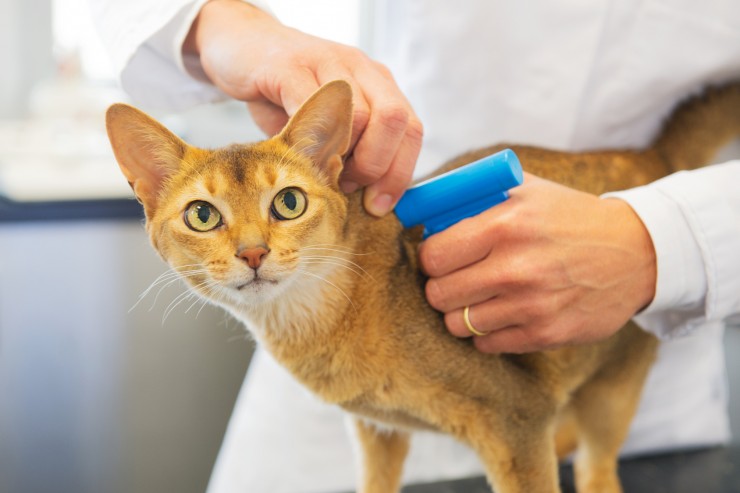

Getting your dog, cat or other pet microchipped is one of the best ways to provide an additional safety net if your pet is lost or stolen, and can help you to recover them safely and quickly if they are found by another pet lover. They can also be used to help you to prove ownership of your pet in the case of any disputes, and once your pet has been microchipped, your pet is sorted with an accurate, permanent form of identification for life!
However, if you have ever been present at the clinic when one of your pets was microchipped, you may have been rather taken aback by the gauge size of the needle used to do this, and the size of the microchip itself. Whilst after chipping has been done, the chip is totally painless and your pet will not even be aware of it, the process itself can give your pet rather a shock, unless chipping is performed as part of your pet’s spay or neuter surgery under a general anaesthetic.
Most of the major microchipping companies have recently begun to introduce a smaller chip to the market, which is aimed at usage in cats, kittens and smaller dogs, but that is also perfectly suitable for larger animals too. In this article, we will look into these in more detail, and discuss why they might be a better microchipping alternative for your own pet. Read on to learn more.
As mentioned, microchipping your pet should be considered as a standard and necessary part of responsible ownership, even if your dog is never let off the lead, or your cat leads an indoor-only life.
Added to this, from 2016 onwards, it will become compulsory in law for all dogs to be microchipped, and for the keeper’s details to be kept up to date in the relevant database. Dog owners and keepers who do not comply with this requirement may face a fine of up to £500.
Microchipping is also required as part of the Pet Passport (PETS) scheme, if you intend to take your pet abroad or bring an animal into the UK.
There are several different companies and developers that provide microchipping kits, scanners, and the relevant information databases to support them in the UK, and depending on the vet that you use to chip your pet, they might use any one of several organisations to supply their tools and chips.
The chip is inserted under the skin (usually at the scruff of the neck for cats and dogs) using a large gauge needle that breaks the skin and inserts the chip simultaneously, in a similar manner to ear piercing guns for people!
Once the chip is in place, a hand-held scanner can be used to read the chip’s ID number, which can then be called in or entered online to one of the various databases, which will either return a full result of the last registered owner of the pet, or advise the person scanning of which company they will need to ask for these details.
Owners can report their pets lost or stolen to the microchipping companies too, which makes reuniting lost pets with their owners easier for all involved. If your pet’s chip is scanned by another party who then contacts the chipping company, the microchipping company will then make contact with you to arrange to reunite you with your pet.
Mini microchips are just like standard-sized microchips, only smaller! They contain a unique serial number in the same way that other chips do, and can be scanned and logged using the same equipment used for other chips.
Standard microchips are inserted with a 12 gauge needle, which is almost 3mm across the diameter-this is a large gauge, which is felt very sharply when inserted into a conscious animal. Mini microchips are around a third of the size of a standard microchip, and so, are inserted with a smaller needle-usually equivalent to a 16 gauge needle, or one that is just over 1.5mm across, or 60% smaller.
Once your pet’s microchip has been inserted and the small puncture wound left behind has healed, mini and standard microchips function in exactly the same way. However, the core advantage in asking for a mini microchip for your pet is that it is smaller, and so less invasive and painful to insert.
If your pet will be microchipped whilst under a general anaesthetic, such as will happen if your pet is microchipped whilst being neutered, a smaller chip will not make a massive difference. But if your pet will be chipped whilst conscious, such as when they go along for their first vaccinations, or if you attend a microchipping clinic, your pet, particularly if they are a small, delicate dog such as an Italian greyhound , a puppy of any breed, or a cat or kitten, will definitely find a mini chip less painful.
Many vets have already begun to offer mini microchips as an alternative to their clients, although these are generally a little more costly to provide. If your vet doesn’t offer them as standard, they will usually be able to order one in for you, upon request.
If you attend a microchipping clinic, charity-led microchipping drive or other means of getting a low cost, on the spot microchip inserted, however, you are unlikely to be offered the alternative of a mini microchip.
Copyright © 2005-2016 Pet Information All Rights Reserved
Contact us: www162date@outlook.com